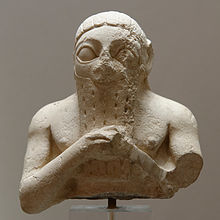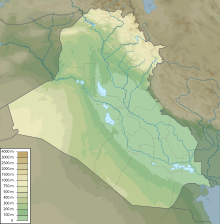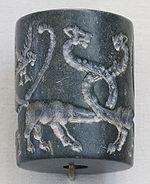அதாப், சுமேரியா
| அதாப் நகரம் அதாப், உதாப் | |
|---|---|
| மாற்றுப் பெயர் | பிஸ்மியா |
| இருப்பிடம் | வசிட் மாகாணம், ஈராக் |
| பகுதி | மெசொப்பொத்தேமியா |
| ஆயத்தொலைகள் | 31°56′49″N 45°58′8″E / 31.94694°N 45.96889°E |
| வகை | தொல்லியல் மேடு |
| பகுதிக் குறிப்புகள் | |
| அகழாய்வு தேதிகள் | 1885, 1890, 1902, 1903–1904 |
| அகழாய்வாளர் | வில்லியம் அய்ஸ் வார்டு, ஜான் புன்னட் பீட்டர்ஸ், வால்டர் ஆண்ட்ரே அந்திரேயே, எட்கர் ஜேம்ஸ் பேங்க்ஸ் |

அதாப் அல்லது உதாப் (Adab or Udab) (சுமேரியம்: (ஆப்பெழுத்தில்|𒌓𒉣𒆠)[1] spelled UD.NUNKI[2])கீழ் மெசொப்பொத்தேமியாவில் அமைந்த பண்டைய சுமேரியாவின் கிர்சு நகரத்திற்கும், நிப்பூர் நகரத்திற்கும் இடையில் அமைந்த பண்டைய அண்மை கிழக்கின் நகரங்களில் ஒன்றாகும். இப்பண்டைய நகரம் தற்கால ஈராக் நாட்டின் வசித் மாகாணத்தில் உள்ள நவீன பிஸ்மியா எனுமிடத்தில் அமைந்துள்ளது.
அதாப் மற்றும் அதன் சுற்றுச்சூழல்[தொகு]

தற்கால ஈராக் நாட்டின் கீழ் மெசொப்பொத்தேமியாவில் அமைந்த பண்டைய நகரமான அதாப் தொல்லியல் மேடு 1.5 கிலோமீட்டர்கள் (0.93 mi) நீளமும், 3 கிலோமீட்டர்கள் (1.9 mi) அகலமும், 12 மீட்டர்கள் (39 அடி) உயரமும் கொண்டிருந்தது. இந்த பண்டைய அதாப் நகரத் தொல்லியல் மேடு, பண்டைய நிப்பூர் நகரத்திற்கு தென்கிழக்கில், டைகிரிசு ஆறு மற்றும் யூப்பிரடிஸ் ஆறுகளுக்கு நடுவே அமைந்திருந்தது.
அதாப் நகரத்தின் வரலாறு[தொகு]
மெசொப்பொத்தேமியாவின் துவக்க வம்ச காலத்திலே (கிமு 2900 – 2350) அதாப் நகரம் நிறுவப்பட்டிருந்தது. சுமேரிய மொழி இலக்கியத்தின்படி, உரூக் காலத்தில் அதாப் நகரத்திலும் இஷ்தர் கடவுள் கோயில் நிறுவப்பட்டிருந்தது.
கிஷ் நகர இராச்சியத்தின் மன்னர் மெசிலிம் அதாப் நகரத்தை ஆண்டதாக, அதாப் தொல்லியல் குறிப்புகள் மூலம் அறியப்படுகிறது. சுமேரிய மன்னர்களின் பட்டியலில் அதாப் நகரத்தை ஆண்ட லுகல்-அன்னே-முண்டுவின் பெயர் உள்ளது. தற்கால வடக்கு சிரியாவில் இருந்த பண்டைய எப்லா தொல்லியல் களத்தில் கிடைத்த களிமண் பலகையில் அதாப் நகரத்தைக் குறித்துள்ளது.[3]
அதாப் தொல்லியல் மேட்டின் அகழாய்வின் போது கிடைந்த கல்வெட்டில் அதாப் நகர மன்னரின் பெயர் லுகால்-தௌடு எனக்குறிப்பிட்டுள்ளது. [4] அதாப் நகர அகழாய்வில் கிடைத்த செங்கல் வில்லைகளில், அக்காடியப் பேரரசர் நரம்-சின் இஷ்தர் கடவுளுக்கு அதாப் நகரத்தில் கோயில் கட்டினார் எனக்குறித்துள்ளது. ஆனால் அகழாய்வில் கோயில் கட்டுமானங்கள் தென்படவில்லை.
அதாப் நகரம், மூன்றாவது ஊர் வம்ச காலத்தில் அதாப் நகரம், ஒரு ஆளுநரின் கீழ் இருந்தது. அம்முராபி இயற்றிய சட்டத் தொகுப்புகளில் சில கல்வெட்டுகள் அதாப் நகரத்தில் கண்டறியப்பட்டுள்ளது.
அதாப் நகர இராச்சியத்தின் ஆட்சியாளர்கள்[தொகு]
| ஆட்சியாளர் | ஆட்சிக் காலம் | குறிப்புகள் | |
|---|---|---|---|
| நின்-கிசல்சி | கிமு 2600 | லகாசு ஆளுநர் | |
| லுகல்தலு | கிமு 2450 | சிலையால் அறியமுடிகிறது. | |
| இ-இக்னிம்பாயி | கிமு 2400 | லுகல்சகெசி ஆட்சியின் சமகாலத்தில் | |
| மெஸ்கிகல் | கிமு 2350 | அக்காடியப் பேரரசரின் சமகாலத்தவர் | |
| லுகலான்நெம்முண்டு | கிமு 2300 | "King of the four quarters of the world" | |
| உர்துமு | ? | சுமேரிய முத்திரை மூலம் என்சி என அறியப்படுகிறார். |
இதனையும் காண்க[தொகு]
மேற்கோள்கள்[தொகு]
- ↑ The Sumerian King List. Accessed 15 Dec 2010.
- ↑ The Cambridge Ancient History. Vol. 1. Part 1. Prolegomena & Prehistory.
- ↑ Eblaitica vol. 3.
- ↑ G.A. Barton, "The Names of Two Kings of Adab", Journal of the American Oriental Society, 33 (1913), pp. 295—296
மேலும் படிக்க[தொகு]
- Edgar James Banks, The Bismya Temple, The American Journal of Semitic Languages and Literatures, Vol. 22, No. 1, pp. 29–34, Oct. 1905
- D. D. Luckenbill, Two Inscriptions of Mesilim, King of Kish, The American Journal of Semitic Languages and Literatures, Vol. 30, No. 3, pp. 219–223, Apr. 1914
- Edgar James Banks, The Oldest Statue in the World, The American Journal of Semitic Languages and Literatures, Vol. 21, No. 1, pp. 57–59, Oct. 1904
- Yang Zhi, The Excavation of Adab, Journal of Ancient Civilizations, Vol. 3, pp. 16–19, 1988
- D. D. Luckenbill, Old Babylonian Letters from Bismya, The American Journal of Semitic Languages and Literatures, vol. 32, no. 4, pp. 270–292, 1916
- Caroline Nestmann Peck, "The Excavations at Bismaya", Ph.d. dis-sertation, University of Chicago, 1949
- Karen Wilson, "The Temple Mound at Bismaya", in Leaving No Stones Unturned: Essays on the Ancient Near East and Egypt in Honor of Donald P. Hansen, Penn State University Press, 2002 பன்னாட்டுத் தரப்புத்தக எண் 978-1-57506-055-2
வெளி இணைப்புகள்[தொகு]
- Oriental Institute page for Bismaya: Recovering the Lost City of Adab பரணிடப்பட்டது 2013-11-15 at the வந்தவழி இயந்திரம்
- Three Ox-drivers from Adab
- Recent article on Edgar James Banks in "World and I"
- NY Times note on the Bismaya excavations dated 1904
- Bismaya "re-excavation" project being funded by Shelby White - Leon Levy Program
- Translation of Three Ox-Drivers from Adab







